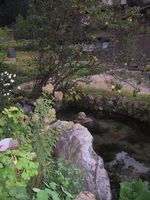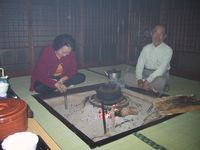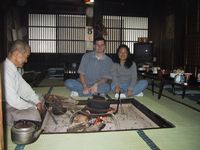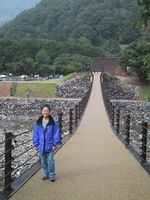
Ogimachi is a small town of about 100 people. The town has many historical homes built in a special thatched A-frame style unique to the region. These homes are over one hundred years old and require constant maintainance to preserve their thatched roofs and wooden structure. The roofs need to be completely replaced every 17 years or so and cost over a million dollars to construct. The houses are very large and originally were multi-family, and most still seem to be so, although many also include rooms for tourists to rent nightly as well. The town itself also includes many other homes and other buildings; most of the industry of the town seems to revolve around supporting the daily contingent of tourists.
We made a beeline for the tourism office upon our arrival in Ogimachi in order to find a room in town. We ended up staying in a nice A-frame home on the edge of town (about a five minute walk from the center of town, which should give you some idea of the size of the place). An elderly woman and her husband lived in part of the house.
| Here's our "hotel" - a very good example of traditional Ogimachi building style. |  |
| This is the hallway outside our room. All of the rooms are separated by sliding wooden doors with paper walls. |  |
Here are some photos from around the town of Ogimachi. The homes of Ogimachi are scattered loosely around a 400-yard or so square area, with various walkways, paths, gardens, canals, and fruit trees filling in the gaps. All in all it was a very peaceful and quiet community.
 |
 |
 |
 |
 |
 |
 |
 |
 |
 |
 This little beagle came rushing out to defend his territory. What a cutie! |
 |
We found our way back to our hotel after a few hours' wandering, just in time for dinner. We found traditional Japanese robes laid out for us, and assumed that they were for us to wear to dinner, so we put them on.
 |
 |
 |
Of course when we were called to the dining room we found that the other guests staying in the hotel that evening - a pair of Japanese women - weren't wearing their robes. Maybe they were supposed to be pajamas and we were wearing them to dinner - how embarrassing! Of course our fellow guests never said a word about it.
The next morning breakfast was served in the same room. This time, however, the old man had started a big smoky fire in the pit in the center of the room. Every day a smoky fire is burned for a while as is necessary to keep the wood and thatch conditioned. It was very, very smoky and although the old man didn't seem to mind, Bryan in particular found his eyes tearing uncontrollably and had trouble breathing.
| The old man stokes the fire, and laughs at the smoke. |  |
 |
 |
Here we are right before Bryan had to leave because he couldn't take the smoke any longer. Note the tears running down his face ... |
After breakfast we walked through town to the road which winds its way up the hillside to an outlook point high above the village. This is generally regarded as the best place around to get a good view of the whole village. Unfortunately it was raining off and on the entire time and the valley was a little foggy, which make photo taking difficult and didn't damper our moods one bit. Who can not be happy after a hot breakfast?
 |
 |
 |
 |
 |
 |
We really liked the Japanese house style and would love to own a home which looked like this someday.
| Nancy poses by a pomegranate tree in town. |  |
Separating the main village from the bus station was a long suspended bridge over what was at one time a big river. The river has since almost completely dried up as many dams have been built upstream.
 |
 |
 |
Look closely at the rightmost photo - you can see Bryan way down at the other end of the bridge. |
After this we boarded a bus destined for our next stop, Kanazawa.
Back to: Japan, October 1 - 4: Arriving and Nori Kura